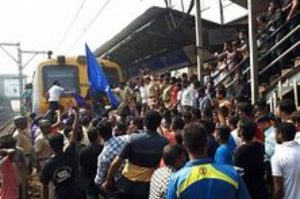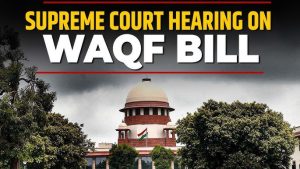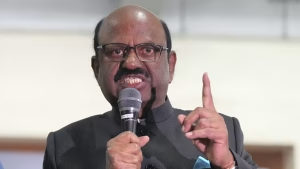West Bengal Governor Murshidabad visit: In the wake of recent unrest in Murshidabad, West Bengal Governor CV Ananda Bose’s scheduled visit to the district on April 19, 2025, has garnered significant attention. The visit comes after a series of violent incidents linked to protests against the Waqf (Amendment) Act, 2025, which resulted in casualties, injuries, and widespread disruption. This article provides an in-depth analysis of the circumstances surrounding the Governor’s visit, the events leading up to it, and the broader implications for the state’s political and social landscape.
Background: The Waqf (Amendment) Act, 2025
The Waqf (Amendment) Act, 2025, introduced significant changes to the administration and governance of Waqf properties across India. The legislation aimed to streamline the management of these properties but was met with criticism from various quarters, particularly in states with substantial Muslim populations like West Bengal. Critics argued that the amendments infringed upon religious freedoms and minority rights, leading to widespread concerns among Muslim communities.
The Waqf Amendment Bill has been a point of contention, particularly among Muslim organizations in West Bengal. They argue that the proposed changes threaten the autonomy of the Waqf Board, which manages endowments for religious and charitable purposes. Leaders from various Muslim organizations have expressed concerns that the amendments could violate Article 14 of the Indian Constitution, which guarantees equality before the law, by singling out the Waqf Board while other religious endowment boards retain their autonomous status. Despite submitting detailed objections and suggestions to the Joint Parliamentary Committee, these organizations feel their concerns have not been adequately addressed.
Murshidabad Protests Against Waqf: Understanding the Waqf Amendment Bill
The Waqf Amendment Bill has become a lightning rod for controversy, not only in Murshidabad but across several minority-dominated regions in India. At its core, the Bill proposes to restructure how Waqf properties are governed and to increase the role of the central government in their oversight. Waqf properties—endowments made by Muslims for religious, educational, or charitable purposes—are traditionally managed by Waqf Boards, which operate under state governments. Critics of the Bill argue that the proposed changes would effectively centralize control and dilute the autonomy of these Boards, undermining a long-standing religious institution.
According to legal analysts and minority rights advocates, one of the most concerning aspects of the proposed amendment is the expanded authority it would grant to the Central Waqf Council and the Union Ministry of Minority Affairs. This includes the ability to unilaterally review and possibly revoke the decisions of state Waqf Boards. Additionally, the Bill calls for stricter eligibility requirements for board members and increased financial scrutiny, which some community leaders see as a veiled attempt to bureaucratize and politicize what should be a religious and charitable domain.
Proponents of the amendment argue that it aims to bring transparency and curb corruption within the Waqf system, which has often been mired in allegations of mismanagement and land scams. However, detractors assert that these goals could be achieved through internal reform, rather than sweeping legislative overreach. For many Muslims, particularly in states like West Bengal, Uttar Pradesh, and Bihar, the Bill evokes a deeper fear—that of losing control over community assets and seeing their religious institutions gradually absorbed into the administrative machinery of the state. This context is vital in understanding why the protests turned so volatile and emotional in Murshidabad, where many families are directly connected to Waqf institutions and fear that their heritage is under threat.
The Murshidabad Violence: A Timeline
April 8, 2025: Protests against the Waqf (Amendment) Act began in Murshidabad, with demonstrators blocking National Highway 12 at Umarpur, disrupting traffic and setting police vehicles on fire.

April 11, 2025: The situation escalated as protesters vandalized public and private vehicles, attacked the office of local Member of Parliament Khalilur Rahaman, and set a police jeep ablaze. Train services were disrupted as protesters squatted on railway tracks and pelted stones at a stationary train at Nimtita railway station.


April 12, 2025: A violent mob attack resulted in the deaths of two members of the same family, Hargobind Das and his son Chandan Das, when their residence was targeted. A 17-year-old, Izaz Ahmed Sheikh, also died after being shot during the unrest. Over 400 people, including women and children, fled from areas like Dhulian, Suti, and Shamsherganj, seeking shelter in neighboring Malda district.
April 13, 2025: Authorities imposed Section 144 of the Criminal Procedure Code in affected areas, restricting public gatherings, and suspended internet services to prevent the spread of rumors. The Calcutta High Court ordered the deployment of central forces to restore order.
The sequence of events in Murshidabad leading up to the widespread protests offers critical insights into the eruption of violence that followed. What began as sporadic demonstrations in early April quickly morphed into coordinated acts of unrest, reflecting a growing unease among local populations. The first visible signs of dissent appeared around April 4th, when various Muslim organizations organized peaceful rallies against the proposed Waqf Amendment Bill. These protests were initially non-violent, with participants holding placards, chanting slogans, and submitting memoranda to local authorities.
By April 6th, tensions began to escalate following a joint victory rally organized by the Congress and CPI(M) in the area. Witnesses say that the atmosphere turned volatile when protestors, frustrated by what they perceived as political indifference and provocation, clashed with law enforcement officers deployed at the scene. The confrontation quickly turned violent. Stones were hurled, police resorted to lathi charges, and several arrests were made. The Raninagar police station was targeted shortly thereafter, ransacked by mobs who also set several vehicles on fire.
April 7th marked a significant turning point. Violence intensified across multiple pockets of Murshidabad, particularly in areas like Raghunathganj, Domkal, and Berhampore. Protesters set ablaze a local TMC party office, and reports surfaced of vandalism at shops owned by Hindu residents. Trains were delayed or canceled as mobs blocked railway lines, while National Highway 34 saw massive traffic disruptions. Internet services were suspended as a precautionary measure to prevent the spread of misinformation and to contain coordination among agitators. Over the next 48 hours, the unrest showed no signs of abating.
By April 9th, the state administration deployed additional paramilitary forces and imposed Section 144 in sensitive areas to restore calm. As the dust settled, hundreds had been detained, dozens injured, and countless properties destroyed. The incident was no longer just a protest against a bill—it had transformed into a broader reflection of community fears, political rivalry, and administrative failure.
West Bengal Governor Murshidabad visit: Governor’s ‘Duare Rajyapal’ Initiative
Governor CV Ananda Bose’s visit to Murshidabad is part of his ‘Duare Rajyapal’ (Governor at Your Doorstep) initiative, launched in November 2024 to mark his two years in office. The program aims to address grievances of marginalized communities by facilitating direct engagement between the Governor and citizens across the state. Under this initiative, the Governor planned to visit 250 locations, focusing on tribal areas, orphanages, old age homes, and regions affected by distress.
Political Reactions and Controversies
The Waqf (Amendment) Act has been a point of contention among various political and religious groups in West Bengal.
West Bengal Jamiat-e-Ulama: The organization held protests against the Act, labeling it an “attack on the Constitution” and alleging that it aimed to strip Muslims of their rights and destroy Waqf properties.
Trinamool Congress (TMC): The TMC Minority Cell organized a rally in Kolkata to protest the Act, with leaders accusing the BJP-led central government of attempting to seize properties of Muslims and undermining the federal structure of the country.
West Bengal Waqf Board: The board expressed opposition to the Act, stating that there was a lack of consultation with stakeholders before its introduction.
Governor’s Stance
Governor Bose emphasized the importance of upholding the law, stating that the Waqf (Amendment) Act is a law passed by Parliament and must be respected by all. He urged the state government to take immediate and stringent measures to curb the violence and restore order. Governor CV Ananda Bose’s visit to Murshidabad underscores the gravity of the situation following the protests against the Waqf (Amendment) Act. His ‘Duare Rajyapal’ initiative aims to bridge the gap between the administration and the marginalized communities affected by the unrest. As West Bengal navigates the complexities arising from the new legislation, the emphasis remains on restoring peace, ensuring justice, and upholding the constitutional values that bind the diverse fabric of the state.
Humanitarian Impact
The violence in Murshidabad led to significant humanitarian concerns:
-
Displacement: Over 400 individuals, including women and children, were displaced due to the unrest, seeking refuge in neighboring districts.
-
Casualties: Three individuals lost their lives, and more than ten were injured during the protests.
-
Arrests: Authorities arrested over 274 people in connection with the violence, registering 60 FIRs.
DO FOLLOW:
Also read: Waqf Act Protest in Bhangarh: 5 Shocking Clashes That Blocked Highways and Shook Bengal



